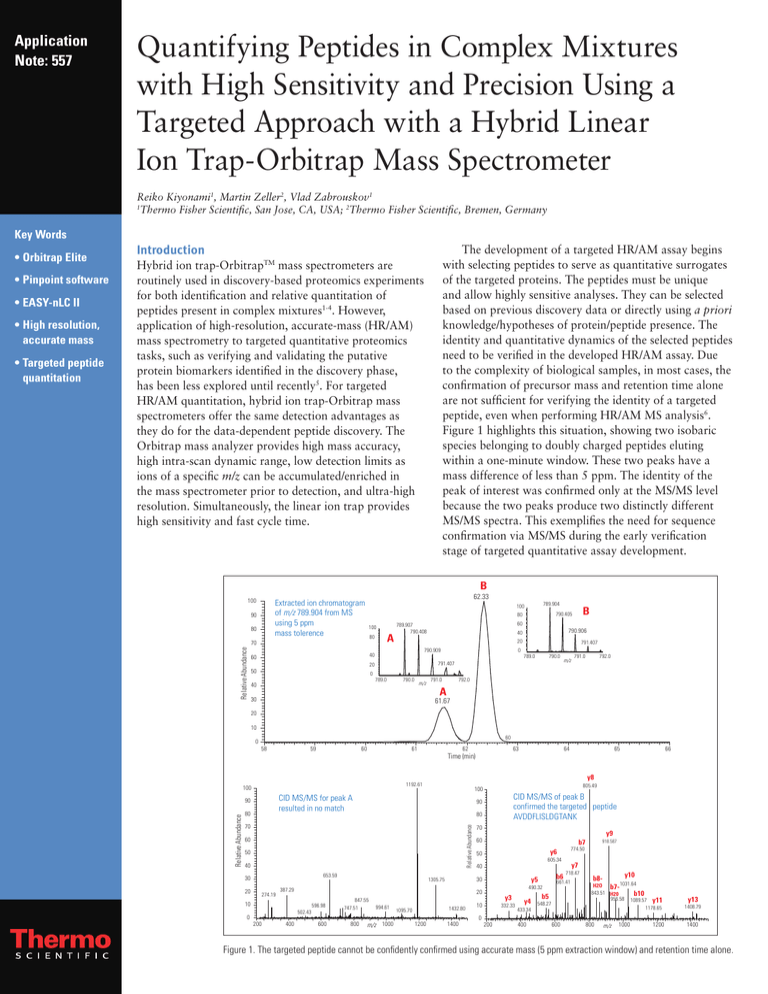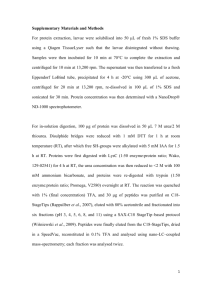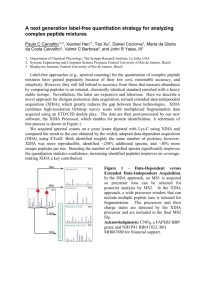
Application
Note: 557
Quantifying Peptides in Complex Mixtures
with High Sensitivity and Precision Using a
Targeted Approach with a Hybrid Linear
Ion Trap-Orbitrap Mass Spectrometer
Reiko Kiyonami1, Martin Zeller2, Vlad Zabrouskov1
1
Thermo Fisher Scientific, San Jose, CA, USA; 2Thermo Fisher Scientific, Bremen, Germany
Key Words
•High resolution,
accurate mass
•Targeted peptide
quantitation
B
100
62.33
Extracted ion chromatogram
of m/z 789.904 from MS
using 5 ppm
mass tolerence
90
80
789.904
100
100
A
80
70
0
40
790.906
40
20
790.909
0
791.407
789.0
790.0
791.407
20
50
60
789.907
790.408
40
60
789.0
B
790.405
80
790.0
m/z
30
791.0
m/z
791.0
792.0
792.0
A
61.67
20
10
60
0
58
59
60
61
62
63
Time (min)
64
65
66
y8
1192.61
100
CID MS/MS for peak A
resulted in no match
90
80
80
60
50
40
20
653.59
274.19
502.43
400
y9
60
b7
605.34
40
600
847.55
747.51
800
994.61
m/z 1000
1432.80
1095.70
1200
1400
490.32
y3
10
0
b6
y5
332.33
200
y4
433.34
400
y7
718.47
661.41
b5
548.27
918.587
774.50
y6
50
20
596.98
200
70
30
1305.75
387.29
10
0
CID MS/MS of peak B
confirmed the targeted peptide
AVDDFLISLDGTANK
90
70
30
805.49
100
Relative Abundance
•EASY-nLC II
The development of a targeted HR/AM assay begins
with selecting peptides to serve as quantitative surrogates
of the targeted proteins. The peptides must be unique
and allow highly sensitive analyses. They can be selected
based on previous discovery data or directly using a priori
knowledge/hypotheses of protein/peptide presence. The
identity and quantitative dynamics of the selected peptides
need to be verified in the developed HR/AM assay. Due
to the complexity of biological samples, in most cases, the
confirmation of precursor mass and retention time alone
are not sufficient for verifying the identity of a targeted
peptide, even when performing HR/AM MS analysis6.
Figure 1 highlights this situation, showing two isobaric
species belonging to doubly charged peptides eluting
within a one-minute window. These two peaks have a
mass difference of less than 5 ppm. The identity of the
peak of interest was confirmed only at the MS/MS level
because the two peaks produce two distinctly different
MS/MS spectra. This exemplifies the need for sequence
confirmation via MS/MS during the early verification
stage of targeted quantitative assay development.
Hybrid ion trap-OrbitrapTM mass spectrometers are
routinely used in discovery-based proteomics experiments
for both identification and relative quantitation of
peptides present in complex mixtures1-4. However,
application of high-resolution, accurate-mass (HR/AM)
mass spectrometry to targeted quantitative proteomics
tasks, such as verifying and validating the putative
protein biomarkers identified in the discovery phase,
has been less explored until recently5. For targeted
HR/AM quantitation, hybrid ion trap-Orbitrap mass
spectrometers offer the same detection advantages as
they do for the data-dependent peptide discovery. The
Orbitrap mass analyzer provides high mass accuracy,
high intra-scan dynamic range, low detection limits as
ions of a specific m/z can be accumulated/enriched in
the mass spectrometer prior to detection, and ultra-high
resolution. Simultaneously, the linear ion trap provides
high sensitivity and fast cycle time.
Relative Abundance
•Pinpoint software
Introduction
Relative Abundance
•Orbitrap Elite
y10
b8-
H2O b7-1031.64
843.51 H20
b10
956.58 1089.57
y11
1178.65
600
800
m/z
1000
1200
y13
1408.79
1400
Figure 1. The targeted peptide cannot be confidently confirmed using accurate mass (5 ppm extraction window) and retention time alone.
To address this issue, we developed a targeted
HR/AM peptide quantitation workflow5 that uses
HR/AM selected-ion monitoring (SIM) for quantitation
and time-scheduled ion trap MS/MS for simultaneous
peptide verification. Figure 2 shows the workflow
employed on a new next-generation hybrid ion trapOrbitrap mass spectrometer. For targeting a large number
of peptides in one HPLC-MS run, multiple SIM scans
with 200 amu isolation windows followed by targeted
data-independent CID MS/MS with scheduled time
windows were used. The relatively large SIM isolation
windows resulted in collection and quantitation of all
the ions within that window, effectively “enriching”
those ions while excluding ions outside the mass range
of interest. This enrichment resulted in a lower limit of
Electronspray Ion Source
Square Quadrupole
with Beam Blocker
S-Lens
Octopole
quantification in much the same way that selectively
collecting peptides on a trapping column would. Because
Orbitrap analyzer detection is the largest contributor
to the cycle time in this workflow, the new hybrid
Orbitrap instrument with a 4-times faster acquisition
rate (at 60,000 FWHM), compared to most current
hybrid Orbitrap instruments,7 is expected to offer better
analytical precision and throughput.
Here we report the results of the targeted
quantification workflow combining HR/AM SIM with
simultaneous CID MS/MS on the new Thermo Scientific
Orbitrap Elite hybrid mass spectrometer. Attention is
focused on the detection limits, dynamic range, and the
analytical precision of the assay.
High-Pressure Cell
Low-Pressure Cell
Quadrupole Mass Filter
C-Trap
HCD Collision Cell
577.57
New High-Field
Orbitrap
Analyzer
Scheduled CID MS/MS
for sequence confirmation
HRAM SIM
Quantitation
668.36
494.44
459.27
340.12
313.18
358.23
350
507.85
886.57
568.39
687.40
611.32
389.14
400
450
628.38
544.32
441.27
500
943.52
815.48
550
600
650
764.33
758.53
746.45
784.47
713.40
700
750
800
859.45
934.47
896.55
959.54
830.54
850
XIC of targeted
peptide
5 ppm mass
tolerance
988.54
929.59
1014.62
900
950
1000
1050
m/z
18.0
18.5
Time (min)
19.0
19.5
Figure 2. Targeted peptide quantitation workflow using an HR/AM approach on the Orbitrap Elite hybrid mass spectrometer. Targeted peptides were quantified
using accurate mass SIM and confirmed simultaneously using time-scheduled CID MS/MS within a single HPLC-MS run.
Goal
To evaluate the sensitivity, analytical precision, dynamic
range and throughput of the targeted quantification
workflow for simultaneously verifying and quantifying
multiple targeted proteins/peptides on a new hybrid
linear ion trap-Orbitrap mass spectrometer, the Orbitrap
Elite™. Accurate masses of targeted peptides in highresolution selected ion monitoring (SIM) mode are
collected for quantitation and the MS/MS spectrum of
each targeted peptide is used for sequence confirmation.
Experimental
Sample Preparation
Sample 1: A mixture of six isotopically labeled yeast peptides
was spiked into a 1-µg yeast digest at five different
concentrations (0.01 fmol/µL, 0.1 fmol/µL, 1 fmol/µL,
10 fmol/µL and 100 fmol/µL)
Sample 2: A yeast digest mixture (1 µg/µL)
Liquid Chromatography
A Thermo Scientific EASY n-LC II was used for all
experiments. The LC conditions were as follows:
Column: PicoFrit® Magic C18 column (75 μm x 150 mm,
3 μm particle size) (New Objective, Woburn, MA)
Flow rate: 300 nL/min; Buffer A: 0.1% formic acid/H2O;
Buffer B: 0.1% formic acid/acetonitrile
Gradient: 5% B to 45% B in 60 min
Sample loading: Directly loaded on column
Injection amount: 1 µL
Mass Spectrometry
An Orbitrap Elite™ hybrid ion trap-Orbitrap mass
spectrometer equipped with a Thermo Scientific
Nanospray Flex ion source was used for all experiments.
The MS conditions were as follows:
Capillary temperature: 220 °C
Spray voltage: 1800 V
S-lens RF level: 50%
FT Resolution: FHWM at m/z 400
AGC target for FT SIM: 1E5
Isolation width of FT SIM: 50 amu for sample 1; 200 amu for sample 2
Targeted data—independent MS/MS lists with
scheduled time windows were used for targeted peptide
verification. For sample 1, three SIM scans were used to
cover all precursor ion mass ranges of the spiked peptides
and the targeted MS/MS list included all of the six
precursor ions without scheduled time windows. For
sample 2, four SIM scans were used to cover 86 yeast
peptides representing 26 yeast proteins. The targeted
MS/MS list included 86 precursor ions with scheduled
time windows. Each sample was run in triplicate.
Workflow to Generate a Targeted MS/MS List for Sample 2
1. A total of 26 yeast proteins were selected from the
literature8,9. Proteins were selected with estimated
cellular abundances ranging from less than 50 copies
per cell to more than 1,000,000 copies per cell to
evaluate the dynamic range of the workflow. The
majority of the selected proteins were of low abundance
(<128 copies/cell).
2. Based on either previous discovery data or in-silico
digestion, peptides with sequences unique to the
targeted proteins were selected as putative candidates
for quantification using Thermo Scientific Pinpoint
software version 1.1. The 2+ and 3+ precursor m/z list
of each candidate was exported as global inclusion
list. The elution time for each peptide was predicted
using linear correlation based on a Thermo Scientific
Pierce Peptide Retention Time Calibration (PRTC) kit.
4-minute windows were used per peptide.
3. The yeast digest was analyzed on the Orbitrap Elite
instrument using full scan at 60,000 resolution in the
Orbitrap mass analyzer and rapid CID MS/MS in a
targeted, data-dependent fashion in the linear ion trap.
Only the precursor ions in the global inclusion list were
triggered. All unidentified candidate peptides in the
first run were exported as an additional global MS/MS
list with a larger 10-minute time window using
PinpointTM software for the second run.
4. The two raw files were searched against the yeast
database with Thermo Scientific Proteome Discoverer
software version 1.3. The first and the second search
results were compiled together to establish a MS/MS
spectral library using Pinpoint software. In the final
HR/AM SIM method, 86 identified peptides representing the 26 targeted proteins were targeted using
four SIM scans (400–600 amu, 600–800 amu,
800–1000 amu, 1000–1200 amu), followed by a
data-independent CID MS/MS scan with a global
MS/MS list. The four SIM scans were acquired
constantly over the total run, which facilitated method
set up by eliminating the need for scheduling SIM
scans. The time schedule of the global MS/MS list was
automatically generated by Pinpoint software based
on the detected retention time of each targeted peptide. A 4-minute time window per peptide was used.
Results and Discussion
Detection Limits, Analytical Precision and Linear
Dynamic Range of the Workflow
The six heavy peptides spiked in the 1-µg yeast
digest were targeted in five samples with different concentrations. Each sample was run in triplicate at each of
the five different concentrations to evaluate the analytical
precision. All six peptides were detected clearly from
the 10-amol level to the 100-fmol level on column and
simultaneously verified by CID MS/MS. Figure 3 shows
one of the targeted peptide clearly detected and quantified
from the complex yeast matrix at the 10-amol (lowest)
concentration level. The peptide identity was confirmed
by CID MS/MS in the same run. Four orders of linear
dynamic range were observed with very good analytical
precision (Figure 4). The %CV was less than 21% for the
peptides at 10-amol level and less than 10% for the four
other concentration levels. Table 1 shows the summary of
the %CV for all five concentration samples.
y10 +2
528.32
100
b12
90
RT: 18.50
SN : 14
BP: 613.3164
100
+2
CID MS/MS
Verification
604.54
y7
80
725.44
70
80
Quantification
70
Relative Abundance
Relative Abundance
10 amol peptide
GISNEGQNASIK*
spiked in 1 µg yeast
5 ppm mass tolerance
90
60
50
y8
y9 +2
40
854.46
484.35
60
y3
30
y5
y4
355.21
50
y10
540.35
426.29
1055.59
294.19
20
y9
y6
40
968.56
668.36
10
30
273.17
800.26
230.11
y11
941.53
1168.67
0
200
20
300
400
500
600
700
800
900
1000
1100
1200
m/z
10
0
17.0
17.5
18.0
18.5
19.0
19.5
20.0
Time (min)
Figure 3. The spiked, isotopically labeled peptide GISNEGQNASIK* was simultaneously quantified using an extracted ion chromatograph from the SIM scan, and its
sequence verified using CID MS/MS.
10.0
9.5
Log (Intensity)
Peptide SAAGAFGPELSR*
spiked in 1 µg yeast digest
R² = 0.9959
2.0%CV
9.0
6.2% CV
8.5
7.5
Run 1
3.1% CV
8.0
Run 2
Run 3
4.5% CV
7.0
20.8% CV
6.5
6.0
0.01
0.1
1
10
100
Amount (fmol)
Figure 4. Four orders of linear dynamic range were observed for the spiked
peptide SAAGAFGPELSR*.
Table 1. Analytical precision for the six targeted isotopically labeled peptides spiked into a 1-µg yeast
digest at varying levels.
0.01 fmol
0.1 fmol
1 fmol
% CV (n=3)
10 fmol
100 fmol
SSAAPPPPPR*
12.6 2.9 1.0 2.81.0
GISNEGQNASIK*
4.1 2.8 3.0 4.33.5
HVLTSIGEK*
15.1 1.3 2.2 2.91.0
IGDYAGIK*
8.2 4.2 8.2 4.15.5
TASEFDSAIAQDK* 12.6 1.3 7.7 8.54.0
SAAGAFGPELSR* 20.8 4.5 3.1 6.22.0
Detecting and Quantifying Low- and High-Abundance
Yeast Proteins in a Single Run
To further evaluate the improved analytical precision of
the workflow offered by the faster Orbitrap acquisition
rates of the Orbitrap Elite instrument, a large HR/AM
quantitative assay that targeted 86 peptides as quantitative surrogates for 26 targeted yeast proteins (Table 2)
was developed and applied to the yeast digest sample
(sample 2). Four SIM scans with a 200-amu isolation
width and one additional targeted data-independent
MS/MS scan using a global MS/MS list containing
86 precursor ions with scheduled 4-minute time windows
were used. The analysis was performed in triplicate. All
raw data files were processed using Pinpoint software
(Figure 5). From the 5-ppm mass tolerance HR/AM SIM
scan, the extracted ion chromatogram of the sum of the
C12 and C13 intensities was used for quantitation. The
CID MS/MS spectra were matched with the MS/MS
spectral library entry for peptide sequence verification.
Reproducibility
Quantitation
Verification
Figure 5. Automatic data processing using Pinpoint software
Because multiple co-eluting peptides can be isolated
within the 2-amu precursor-ion isolation window,
acquired CID MS/MS spectra can include fragment ions
from different peptides. In those cases, there would likely
be no good match with the spectra library while using
all fragment ions from each MS/MS spectra. Pinpoint
software features an innovative spectral match algorithm
that uses multiple sequence-specific fragment ions 10 for
spectral matching, with the number of fragment ions being defined by the user. It compares the relative intensities
of the selected multiple fragment ions from the observed
MS/MS spectra with the MS/MS spectral library. In this
way, contaminant fragment ions from non-target sources
are not involved in the spectral match process and do not
influence the calculation of the spectra match score. As a
result, Pinpoint software enables high-confidence peptide
sequence conformation even with “contaminated CID
MS/MS spectra”. Details of the algorithm Pinpoint software uses for MS/MS spectral match can be found in the
published paper by Prakash et al.10
Scan numbers across a peak from a multipleSIM scheduled MS/MS assay which targeted
86 yeast peptides
90
XIC of m/z 726.846
(TVEQLGQEEYEK)
Orbitrap Elite
9 scans across the peak
for quantitation
Compared to earlier Orbitrap instruments, the
faster Orbitrap acquisition scan speed offered by the
Orbitrap Elite instrument allows shorter cycle times (1
second for four SIM scans plus 1-2 seconds of CID MS/
MS time depending on how many precursor ions are in
one specific time window), yielding more data points
across the chromatographic peak for all targeted peptides
(Figure 6). As a result, higher analytical precision was
observed from the quantitative results acquired on the
Orbitrap Elite instrument compared to that of the LTQ
Orbitrap Velos™ instrument (Figure 6). Table 2 shows
the partial summary of the %CVs for the targeted
peptides representing proteins with different cellular
abundances. All the targeted peptides had CVs below
15% and 96% of the targeted peptides had CVs below
10%.
%CV calculated from a multipleSIM scheduled MS/MS assay which
targeted 86 yeast peptides (n=3)
80
% of 86 targeted peptides
70
XIC of m/z 726.846
(TVEQLGQEEYEK)
LTQ Orbitrap Velos
5 scans across the peak
for quantitation
LTQ Orbitrap Velos
60
Orbitrp Elite
50
40
30
20
10
31.0
31.4
31.8
32.2
Time (min)
32.6
33.0
0
0 -5
11 -15
6 -10
%CV (n=3)
16 -20
Figure 6. Analytical precision improvements due to faster Orbitrap mass analyzer scan speed. More scan points result in better
precision.
Table 2. Partial summary results from the HR/AM assay in which 86 peptides representing 26 yeast proteins were detected and quantified across five orders of
abundance range from over 1,000,000 copies/cell to less than 50 copies/cell in a single HPLC-MS run with excellent analytical precision.
Literature
Abundance Range
Protein Names
%CV Retention Total File Area Total File Area Total File Area
(Copies/Cell)*
n=3
Time
run 1
run 2
run 3
1,018,216
YKL060C sp|P14540|ALF_YEAST Fructose-bisphosphate2
T GVIVGEDVHNLFTYAK
1
54.15
GAIAAAHYIR
421.02
LLPWFDGMLEADEAYFK
563.48
3.85E+09
2.67E+09
1.16E+09
1.61E+07
3.71E+09
2.61E+09
1.08E+09
1.62E+07
3.78E+09
2.66E+09
1.11E+09
1.76E+07
870,578
YLR249W sp|P16521|EF3A_YEAST Elongation factor V LEELFQK
LSVATADNR
LVEDPQVIAPFLGK
SNFATIADPEAR
IAVIGPNGAGK
2.26E+09
4.61E+08
4.11E+08
6.38E+08
4.37E+08
3.13E+08
2.37E+09
4.75E+08
4.23E+08
7.09E+08
4.60E+08
3.05E+08
2.37E+09
4.79E+08
4.23E+08
7.03E+08
4.50E+08
3.11E+08
3
2
34.81
216.63
644.81
329.37
129.7
< 128YKL145W sp|P33299|PRS7_YEAST 26S protease 1
3.16E+07
3.17E+07
3.23E+07
regulatory subunit 7 homolog
S YGAAPYAAK
2
18.14
7.23E+06
7.53E+06
7.41E+06
LGEEHPLQVAR
136.08 1.79E+07 1.82E+07 1.84E+07
EVVELPLLSPER
443.53 6.48E+06 6.01E+06 6.53E+06
< 50YJL167W sp|P08524|FPPS_YEAST Farnesyl pyrophosphate synthase
T VEQLGQEEYEK
IGTDIQDNK
IEQLYHEYEESIAK
< 50YDR150W sp|Q00402|NUM1_YEAST Nuclear migration protein
L GHTVVSNEAYSELEK
ILNILGDPSIDFLK
1
1.45E+08
1.43E+08
1.44E+08
1
23.92
3.47E+07
417.24 8.97E+07
1035.16 2.02E+07
3.53E+07
3.57E+07
8.43E+07 8.32E+07
2.31E+07 2.48E+07
3
1.75E+07
1.83E+07
1.86E+07
3
34.27
1.78E+07
154.13 4.29E+05
1.70E+07
1.81E+07
4.36E+05 4.42E+05
3
3
43.09
1.27E+07
1.27E+07
1.33E+07
1.33E+07
1.34E+07
1.34E+07
o expression detected YJL008C sp|P47079|TCPQ_YEAST T-complex protein 15
N
Q
GYNSYSNADGQIIK
8
31.63
GTVLLHNAQEMLDFSK
846.42
LGAPTPEELGLVETVK
841.46
GATQNNLDDIER
622.79
7.56E+07
1.58E+07
1.11E+07
2.97E+07
1.91E+07
8.05E+07
1.62E+07
9.60E+06
3.40E+07
2.08E+07
8.36E+07
1.82E+07
9.78E+06
3.43E+07
2.13E+07
No expression detectedYNL208W sp|P40159|YNU8_YEAST Uncharacterized
3
protein
T GAPNNGQYGADNGNPNGER
1
16.21
QQEQYGNSNFGGAPQGGHNNHHR6 19.9
QDNNNNNGGFGGPGGPGGQGFGR5 27.03
1.28E+06
1.31E+06
1.36E+06
2.15E+05
3.96E+05
6.68E+05
2.18E+05
4.49E+05
6.43E+05
2.20E+05
4.34E+05
7.08E+05
o expression detected YFL037W sp|P02557|TBB_YEAST Tubulin beta chain
N
M
MATFSVLPSPK
YPGQLNSDLR
LAVNLVPFPR
NMMAAADPR
3
1
40.11
727.66
542.86
319.84
1.22E+08
1.58E+07
4.81E+07
3.47E+07
2.39E+07
1.19E+08
1.61E+07
4.49E+07
3.34E+07
2.50E+07
1.14E+08
1.60E+07
4.19E+07
3.12E+07
2.53E+07
No expression detectedYDR381W sp|Q12159|YRA1_YEAST RNA annealing
protein YRA1
E FFASQVGGVQR
LNLIVDPNQRPVK
2
5.38E+07
5.14E+07
5.29E+07
< 50
YOR120W sp|P14065|GCY_YEAST Protein GCY
T WELMQELPK
6
30.96
2.23E+07
2.03E+07
2.01E+07
331.2 3.14E+07 3.12E+07 3.28E+07
No expression detected YDR321W sp|P38986|ASPG1_YEAST L-asparaginase 12
L GTGGTIASK
3
21.42
TNANSLDSFNVR
429.66
SMDGMVPIANVPK
435.47
6.95E+07
3.37E+07
1.20E+07
2.38E+07
7.27E+07
3.59E+07
1.09E+07
2.59E+07
7.13E+07
3.47E+07
1.14E+07
2.52E+07
No expression detectedYCL018W sp|P04173|LEU3_YEAST 3-isopropylmalate
dehydrogenase
V NPIATILSAAMMLK
6
3.95E+05
3.88E+05
3.54E+05
6
3.95E+05
3.88E+05
3.54E+05
61.53
* Ghaemmaghami, S., Huh, W.K., Bower, K., Howson, R.W., Belle, A., Dephoure, N., O‘Shea,
E.K., Weissman, J.S. (2004) Global analysis of protein expression in yeast. Nature. 425: 737-41.
Conclusion
References
In addition to these
• A workflow for simultaneous quantification and
verification of targeted peptides in complex mixtures was
developed and evaluated using an Orbitrap Elite hybrid
mass spectrometer. Targeted peptides were quantified using
SIM with wide windows and HR/AM. Identities of the
targeted peptides were verified using scheduled ion trap
MS/MS in the same LC run.
1. P
an, C., Olsen, J.V., Daub, H.; Mann, M. Mol. Cell. Proteomics 2009,
8, 2796–2808.
Scientific maintains
• The LOD was as low as 10 amol for six heavy peptides
spiked into the samples. Linear dilution curves were
established across 4 orders of dynamic range – from 10
amol to 100 fmol – with good analytical precision for all
six peptides.
• With the established workflow, targeted yeast proteins
covering 5 orders of cellular abundance were detected and
quantified in a single LC-MS run. The faster scan rate of
the Orbitrap mass analyzer in the Orbitrap Elite instrument resulted in improved/excellent analytical precision
within this experiment. All 86 targeted peptides had CVs
below 15% and ninety-six percent of the targeted peptides
had CVs below 10%.
offices, Thermo Fisher
2. D
ayon, L., Turck, N., Kienle, S., Schulz-Knappe, P., Hochstrasser,
D.F., Scherl, A., Sanchez, J.C.; Anal Chem. 2010, 82, 848-858.
a network of represen­
3. W
ang, G., Wu, W.W., Zeng, W., Chou, C.L., Shen, R.F.; J. Proteome Res.
2006, 5, 1214-1223.
throughout the world.
tative organizations
4. J affe, J.D., Keshishian, H., Chang, B., Addona, T.A., Gillette, M.A.,
Carr, S.A.; Mol. Cell. Proteomics 2008, 7, 1952-1962.
5. K
iyonami, R., Prakash, A., Hart, B., Cunniff, J., Zabrouskov, V.; Thermo
Scientific Application Note #500, 2010.
6. Mann,
M., Kelleher, N.L.; Proc. Natl. Acad. Sci. U.S.A. 2008, 105,
18132–18138.
7. D
enisov, E., Damoc, E., Makarov, A., Lange, O.; ASMS poster, 2011,
MP 107.
8. G
haemmaghami, S., Huh, W.K., Bower, K., Howson, R.W., Belle, A.,
Dephoure, N., O’Shea, E.K., Weissman, J.S.; Nature 425, 737-741.
9. Picotti,
P., Bodenmiller, B. B., Mueller, L. N., Domon, B., Aebersold, R.;
Cell 2009, 138, 795-806.
10. P
rakash, A., Tomazela, DM., Frewen, B., Maclean, B., Merrihew, G.,
Peterman, S.; Maccoss, M.J. J. Proteome Res. 2009, 6, 2733-2739.
• Throughput (number of targets) was significantly increased
by using a wide isolation width (200 amu) for SIM in the
Orbitrap mass analyzer and a time-scheduled global
MS/MS list for the ion trap.
• The developed workflow can be used for targeted
quantitation of any protein and delivers highly sensitive
and reproducible quantitative results with high throughput.
Africa-Other
+27 11 570 1840
Australia
+61 3 9757 4300
Austria
+43 1 333 50 34 0
Belgium
+32 53 73 42 41
Canada
+1 800 530 8447
China
+86 10 8419 3588
Denmark
+45 70 23 62 60
Europe-Other
+43 1 333 50 34 0
Finland/Norway/
Sweden
+46 8 556 468 00
France
+33 1 60 92 48 00
Germany
+49 6103 408 1014
India
+91 22 6742 9434
Italy
+39 02 950 591
Japan
+81 45 453 9100
Latin America
+1 561 688 8700
Middle East
+43 1 333 50 34 0
Netherlands
+31 76 579 55 55
New Zealand
+64 9 980 6700
Russia/CIS
+43 1 333 50 34 0
South Africa
+27 11 570 1840
Spain
+34 914 845 965
Switzerland
+41 61 716 77 00
UK
+44 1442 233555
USA
+1 800 532 4752
www.thermoscientific.com
Legal Notices: ©2011 Thermo Fisher Scientific Inc. All rights reserved. PicoFrit is a registered trademark of New Objective, Inc. All other trademarks are the
property of Thermo Fisher Scientific Inc. and its subsidiaries. This information is presented as an example of the capabilities of Thermo Fisher Scientific Inc.
products. It is not intended to encourage use of these products in any manners that might infringe the intellectual property rights of others. Specifications, terms and
pricing are subject to change. Not all products are available in all countries. Please consult your local sales representative for details.
Part of Thermo Fisher Scientific
Thermo Fisher Scientific,
San Jose, CA USA is ISO Certified.
AN63499 _E 11/11S




